Wednesday we broke up our routine of boat work and procrastinating to avoid doing boat work by taking a trip into Cape Town. Our first stop was the Brazilian consulate where we applied for visas. Brazil has an annoyingly fair approach to Visa fees. The price for a Brazilian visa is about $30, unless you come from a country that charges more than that for a Brazilian to obtain a tourist visa to visit your country. In that case, the rate is based on reciprocity: you pay what they pay. Since we’re from the US, it’s 7 times the normal rate, or more than $200 per person. Ouch! We’d already applied online, so the process was pretty standard: sign the forms, prove you’re not broke, pay the fees, and hand over a mug shot. We should have visas in a week, which is about when we’re planning to leave.
The next stop was one of Cape Town’s biggest tourist attractions, and is definitely a must-do while you’re here. Robben Island (Dutch/Afrikaans for Seal Island), is sort of like the Alcatraz of South Africa. The first political prisoners were held there starting in the mid 17th century, with some coming from Dutch colonies as far away as Malaysia. It’s also been home to non-political criminals, a leper colony, a whaling station, a quarantine station, a “lunatic” asylum, feral cats, Australian rabbits, a very lonely man named Robert Sobukwe, and of course Nelson Mandela.
Sobukwe founded the Pan African Congress, which was a competitor to the African National Congress (of which Nelson Mandela was a member). One of the key difference between the PAC and ANC was that the PAC held to more of an “Africa for Africans” stance, while the ANC encouraged membership for and co-operation with members of all ethnic groups present in South Africa. The PAC was behind the demonstrations that led to the Sharpeville massacre of 1960, when a crowd of 20,000 gathered at a police station with 20 officers (later reinforced to 150 officers). The protest was against the pass system, which heavily restricted the movement of black South Africans. Some of the protestors were armed with stones, the police had sub-machine guns, and in the end 69 protestors were killed and 180 wounded, many in the back as they were fleeing. As the leader of the protest, Sobukwe was sentenced to 3 years for incitement. When his 3 years were up, the government took advantage of a new law that allowed indefinite postponement of release and kept him for several years on Robben Island in a small house apart from all other prisoners and forbade him to speak to anyone. When he finally left the island (for house arrest and monitoring in Kimberly) he could barely speak due to atrophy of his vocal chords.
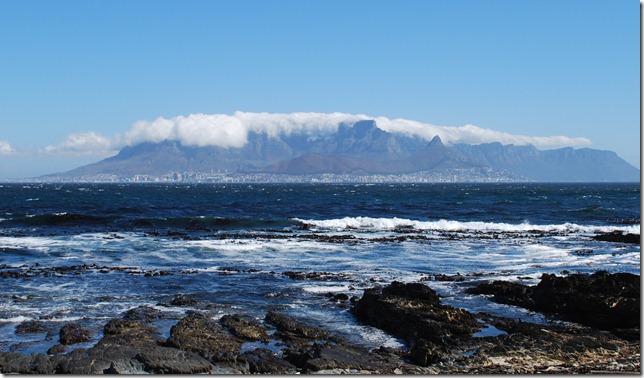 View of Cape Town and Table Mountain from the shore of Robben Island
View of Cape Town and Table Mountain from the shore of Robben Island
Our tour guide for the bus trip around the island was a humorous and entertaining Indian named Yasin Mohamed who leads VIP tours (kings, queens, Obama, Bill Cosby, etc.) and worked as a international fundraiser and representative for the PAC overseas during the apartheid years. He’d had the opportunity to meet Sobukwe, Mandela, and many others who were a part of the struggle for universal suffrage. He had plenty of interesting things to say, but a few things really stood out. One was that the Sharpeville massacre created a need for a Robben Island political prisoner unit because the government realized that black (and Indian) South Africans were now willing to die to end apartheid and obtain the right to vote. Another was how incredibly important countries like Sweden, Switzerland, India, the United States, and many others were to ending apartheid. Their decisions to support sanctions, provide educational opportunities and scholarships, and allow dissidents to live, travel, and raise funds abroad were instrumental to the efforts to end apartheid. He also discussed the apartheid government’s intentional denial of education and skilled jobs to black South Africans – most of the handful of educated blacks in the 60’s were educated by missionaries or in foreign schools, many political prisoners arrived at Robben Island illiterate, and poor education was one of the many factors leading to protests throughout apartheid. The apartheid education legacy is still impacting South Africa today.
One of the unique parts of a Robben Island tour is that the tour of the prison facilities is conducted by a former Robben Island political prisoner. That’s where we met Parks, a convicted terrorist. He was tall, shy, gentle, and had a large belly. I don’t think it’s common knowledge in the US, but after realizing that the South African government was not going to end apartheid due to peaceful protests, Nelson Mandela founded a secret, military branch of the ANC whose name translated to English is “Spear of the Nation”. It was dedicated to sabotage and other violent forms of protest. Peaceful protests and anti-government political activity had been criminalized and many political leaders, including Nelson Mandela, had been “banned”, which meant that they could not participate in political activity, meet with a group of people, or travel, and that it was illegal for anyone to publish their picture or words. Parks joined the “Spear of the Nation” and within two years was arrested and convicted of terrorist activities including being a member of a terrorist organization, recruiting people to join the organization, and illegal possession of firearms and explosives.
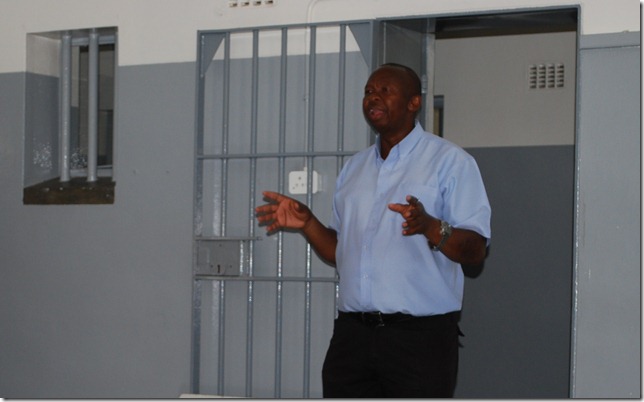 Parks telling us about his time as a prisoner on Robben Island
Parks telling us about his time as a prisoner on Robben Island
Parks spent about 7 years on Robben Island as a political prisoner and was released in 1990, about the time I was starting high school. We sat in the communal cell for general political prisoners where he was held as he told us about life in the prison. 60 prisoners lived in the communal cell, sleeping on the concrete floor using only simple mats (after 15 years of petitioning basic prison beds were finally provided). Each prisoner’s complete bedding consisted of 3 blankets that had to be folded in a particular way every morning to avoid being punished with solitary confinement and beatings. Even in the summer, the wind is cold, but during the winter is much worse, and the howling wind and rain would come into the cell through the open, barred windows. Showers were at 4:30 am three times a week with cold water in a communal shower with 3 shower heads. If any of the 60 prisoners didn’t get a chance to properly shower in the short time provided, they were punished with solitary confinement and no food for a day. Apartheid extended even to the prison, where inmates were housed and treated differently based on race. Unlike the other prisoners, black prisoners were only allowed short pants and short-sleeve shirts, were not given jackets, and were not allowed socks and shoes. They also weren’t allowed to eat bread like the other prisoners. It’s definitely compelling to hear first-hand what so many people went through for what all boiled down to the right to vote in the country where they lived. It may be an incredibly popular tourist experience, but shaking hands with Parks at the end of the tour was still something special.
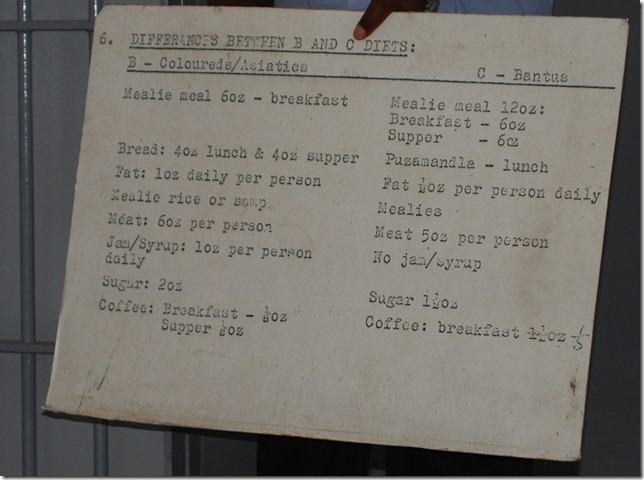 Dietary differences for coloureds/Asians versus blacks (Bantus).
Dietary differences for coloureds/Asians versus blacks (Bantus).
There are so many amazing stories from the apartheid-era Robben Island prison that it’s impossible to include them all here. Lauren and I were lucky to have a copy of Nelson Mandela’s autobiography “Long Walk To Freedom” on the boat and were able to read it in the Pacific. We’d definitely recommend it to anyone. Mandela’s story of growing up in a dirt-floored hut, leading an opposition organization, being imprisoned for 18 years, and then leading a newly integrated country is amazing not only for what it is, but for what a unique person and leader Mandela is. Africa is no stranger to men going from prisoner to Prime Minister in the course of 24 hours, but Mandela’s approach to leadership is very unique in general and especially on the African continent. During the tour we were able to see Nelson Mandela’s cell and the courtyard where the first draft of his autobiography was hidden in a corner in the garden that he started while imprisoned there (when the authorities found it, Mandela was punished by not being able to continue his correspondence studies for 4 years). Mandela and other leaders of the anti-apartheid movement were kept in cells by themselves in a unit apart from the other prisoners in an attempt to lessen their impact and influence on the other prisoners.
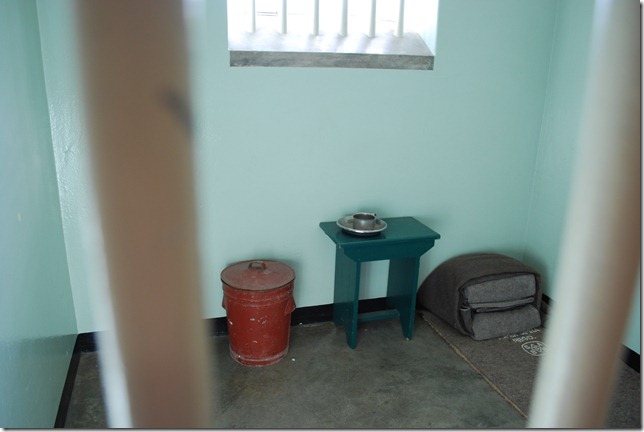 Mandela’s 2m x 3m cell. From (L) to (R): toilet, table with dinnerware, mat/bed with 3 blankets folded as required by authorities
Mandela’s 2m x 3m cell. From (L) to (R): toilet, table with dinnerware, mat/bed with 3 blankets folded as required by authorities
The ferry ride back into the wind and waves left us both surprised that we didn’t see anyone puking, although several people did look like they couldn’t have made it much longer. Back ashore the crew from Marionette was waiting for us and we enjoyed a chance to socialize with them and enjoy some good Mexican food before heading back to Simon’s Town to continue preparations for crossing the Atlantic.
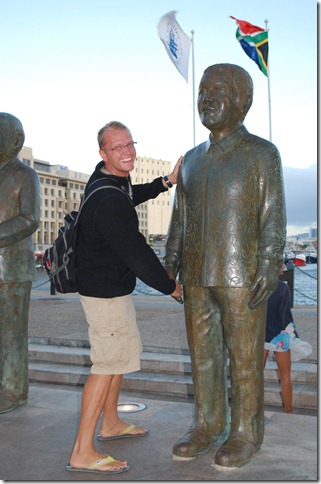 Umkhonto we Sizwe (Spear of the Nation) founder Mandela is one of four SA Nobel Peace Prize winners with bronzes at the V&A Waterfront
Umkhonto we Sizwe (Spear of the Nation) founder Mandela is one of four SA Nobel Peace Prize winners with bronzes at the V&A Waterfront
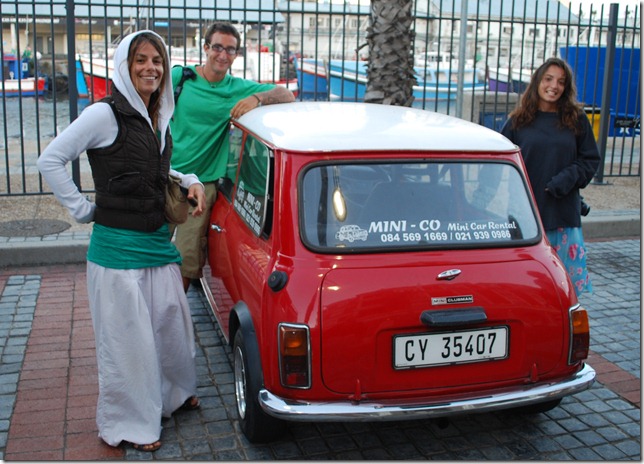 Fitting all 6 of us into Marionette’s old-school mini Cooper turned a few heads
Fitting all 6 of us into Marionette’s old-school mini Cooper turned a few heads

